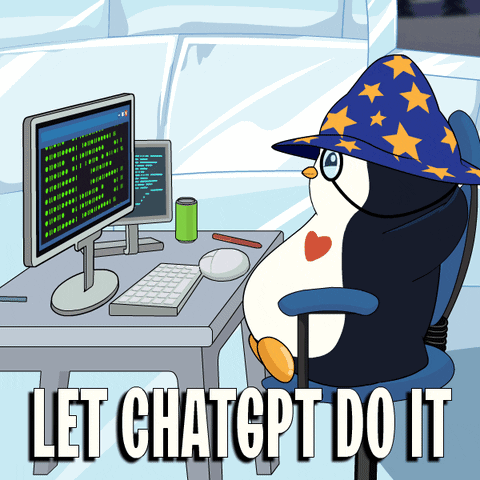Are AI-Created Courses Taking Over Or Destined to Fail? What You Need to Know for 2025 (& Beyond)
If you've been online at all in the last year or two, you've definitely seen people who want to show you how to build a course using AI.

Just type in... stuff... let the AI do its magic, and voila! An amazing course just drops out the other end.
Sounds pretty awesome, right?
Okaaaaaaay. Where do I start here?
Maybe by saying: Yep, AI can be an amazing tool, but there's a huge difference between auto-generating a course that just exists and crafting one that actually delivers the goods – for you AND your students.
So, should you jump on the AI course creation bandwagon?
Honestly? It's a big fat NO if you want a course that truly stands out, creates real success and transformations for people, and buids your reputation.
Stick with me, and I'll break down why relying only on AI to create your online course is a recipe for disaster. Plus, I'll tell you about the ONE thing AI absolutely CAN'T do that's absolutely crucial for crushing it as a course creator in 2024 and beyond.
AI, Our New Overlords?...
When ChatGPT dropped in December 2022, it blew our collective minds.

Suddenly, AI tools and AI-generated content were everywhere, promising to make life a breeze, supercharge productivity, and yeah, even cook up entire online courses for you.
The possibilities seemed endless: brainstorming ideas, creating content, automating boring tasks, and even helping with marketing. For many, it felt like the ultimate shortcut to building a money-making course without all the headaches.
And the truth is that while AI might be great at spitting out information, this is ironically the very problem with AI-generated courses – they're just ... information.
And information alone isn't enough to create a killer online course. There's so much more that you need to include in a course if you want it to be successful.
Information Overload aka the "Thud" Factor
You know, that satisfying "thud" when something heavy lands on your doorstep?
That's the "thud" factor.
It's an outdated idea that more stuff = more value.
When applied to courses, the more information, the more value.
This used to be true, back in the day when literally unlimited information wasn't available to everybody.
But today?
We're in information overload, overwhelmed, exhausted.
And that's what an AI-generated course feels like. When students get bombarded with endless modules, lessons, and resources, they don't get value. They get the literal opposite: overwhelm, frustration, panic.
Information Alone Just Isn't Enough
If access to all of the information could solve all our problems, we'd all be living in Googletopia – or ChatGPTopia – by now.
We'd be rich, happy, healthy, and thriving because we'd have all the answers at our fingertips, 24/7.
But we're not!
That's because information doesn't magically turn into action. And without action, nothing changes. No new habits form. No identity shifts take place. And no new results come into our lives.
This is the biggest mistake I see course creators making with AI.
They think that stuffing their course with as much info as possible is going guarantee success. But in reality, it's a recipe for refunds, low completion rates, and sales that fall off a cliff.
How We Learned This Lesson
Back in 2012, we launched our first big course, Message to Money, featuring our Live Your M.E.S.S.A.G.E. System.
Looking back, I realize that it was actually six courses in one, all jammed into a single 6-week program.

My partner and I spent months creating the content, building the sales page, writing the emails, and putting everything together. And while we made some sales, the cracks quickly started to show.
Refund rates were through the roof, and when I dug deeper, I discovered that only around 5% of our students were actually finishing the course.
The rest? Overwhelmed, frustrated, and dropping like flies.
It was a tough pill to swallow, but it taught me a valuable lesson: more information isn't the answer.
What really matters is: how you engage your students and get them to take action.
The Real Secret to Course Success is "Experiential Learning"
So, if AI-generated information isn't the secret sauce, what is?
It's all about creating an "experience" – or what I like to call an "Experience Product" (instead of an "Information Product.")
The "experience" part is the magic that gets your students into action, keeps them hooked, and drives real results.

An Experience Product is specifically designed to create certain kinds of experiences proven to "light a fire" under your students to take consistent action.
It's all about moving them from information overload – into to action, and then actual transformation.
Here are four critical experiences we've identified that you MUST bake into your course to make it truly effective:
- Shared Experiences: We crave connection and community. So build an engaged cohort where students can support and learn from each other, whether through group coaching calls, virtual events, or online forums.
- Constant Wins: Create a game-like experience where your students can achieve small, easy wins that build their confidence and keep them fired up. Instead of saving the rewards for the end, offer micro-rewards throughout the course.
- Emotional Experiences: Engage your students on an emotional level. Use storytelling, multisensory language, and pattern interrupts to keep them invested and excited about their progress.
- Variable Rewards: Celebrate the progress of your students randomly, throw in "Easter Eggs", surprises, memes, gifs, pattern interrupts and generally have a good time. People crave surprise & delight and they'll pay money to get it.
Real-World Examples of Experiential Learning in Action
To truly get what experiential learning is, let’s look at some real-world examples that showcase how creating unique experiences can lead to massive engagement and success for your students AND your course.
Fitbit: Fitbit isn’t just a fitness tracker — it’s a personal coach, motivator and accountability partner all rolled into one. This wearable tech transforms daily steps and heart rate monitoring into a game where you're winning and being rewarded every time you take action.
Every time you meet a goal or reach a milestone, Fitbit responds with celebrations and encouragement, making it feel like you have a coach cheering you on every step of the way. This personalization keeps users engaged and motivated, turning a simple product into a transformative experience.
Spotify: Spotify revolutionized the music industry by turning the act of listening to music into a shared, social experience. Through features like collaborative playlists, real-time listening sessions and personalized song recommendations, Spotify turned music from a solitary activity into a community-driven experience.
Users don’t just listen to music; they share it, discover it together and bond over their favorite tunes. This shared experience has been key to Spotify’s success, driving user engagement and loyalty.
Taylor Swift’s Eras Tour: Taylor Swift’s Eras Tour is a masterclass in creating unforgettable, experiential events. Understanding that her largely Gen Z audience craves participation and social connection, Swift designed a tour that was much more than just a series of concerts.

Each show became an immersive experience, complete with themed costumes, fan participation and exclusive moments that felt tailored just for the attendees. Fans weren’t just passive spectators; they were active participants in a once-in-a-lifetime event.
The result?
Swift’s tour became a cultural phenomenon, dominating social media and selling out venues worldwide. This level of engagement and emotional connection is something NO AI-generated experience could replicate.
Experience Product Masterclass: Now, let’s talk about something close to home — our signature program — the Experience Product Masterclass (EPM).
EPM is a program that's designed around the principles of experiential learning.
When Davina and Galen Detrick first joined EPM, they were ready to create a traditional info-product for dentists. But after the first week in EPM, they realized the future was in creating experiences, not just delivering information.
They changed their approach and built an experiential course that took their students on a journey rather than just providing content.
The result?
They didn’t just create one successful course; they built an online course empire with 12 courses and counting. Davina even retired from practicing dentistry to focus on their thriving online business, proving that experiential learning doesn’t just benefit students — it can transform the lives of course creators, too.
Why AI Alone Can’t Create These Experiences
While AI is fantastic for generating tons and tons of content, it can’t create the kind of personalized, engaging experiences that are needed for real transformation.
Why?
Because experiences are human.
They require empathy.
Understanding.
A deep connection with your students.
AI can’t replace the human touch that’s essential for building trust, motivating action and creating lasting change.
Yes, AI can assist in the process, but it shouldn’t be the sole creator of your course. It’s your job to design the experiences that will get your students results — AI is just a tool to help you do that more efficiently.
Looking Ahead: The Future of Online Courses in 2025 and Beyond
As we move into 2025, the landscape of online courses will naturally continue to evolve. AI will play a bigger role in course creation, marketing and delivery, but the fundamental principles of what makes a course successful won’t change.
The courses that will stand the test of time are those that go beyond just delivering information. They’ll be the ones that create transformative experiences for their students — experiences that inspire action, foster connection and drive real results.
So, as you plan your next course, remember this: AI can be a powerful ally, but it’s not a replacement for the human experience. Focus on creating an Experience Product that gets your students into action, and you’ll set yourself up for success in 2024 and beyond!
The first step to creating a course that will sell for many years to come? The right idea!
So, mark your calendar for October 1 – October 5, 2025 for our once-a-year FREE 5-Day Challenge, where together with Marisa, Xperiencify's co-founder, we’ll crack your Home Run Course Idea!

The wrong idea can cause you months or even years of frustration…
While the right idea could be life-changing.
We can’t wait to see you in the Challenge (I only do this FREE once a year, so don’t miss it and be sure to tell your friends 🙂
To make sure you receive the invite, be subscribed to our newsletter.
Murray loves building software platforms that make life easier for marketers and entrepreneurs. It's all he does. He's built many tools over the years and helped thousands of people start and grow their business, which is his driving motivation.
His latest project is Xperiencify -- a new LMS / online course platform that fixes the "dirty secret" of the online course industry (which is that 3% of people get results from the course they buy.) They do it with a powerful combination of psychology 🧠, gamification 🕹️ and Silicon Valley "black magic". 🥷